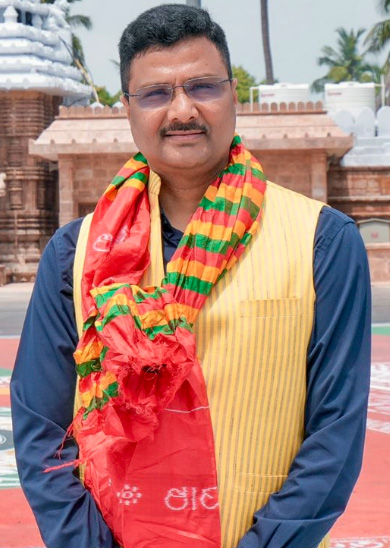Puri: Devotees worldwide rejoiced today as Dr. Arabinda Padhee, Chief Administrator of the Shree Jagannath Temple Administration (SJTA), confirmed that all “Nitis” (rituals) for Netrotsav and Nabajouban Darshan are proceeding precisely as scheduled. This assurance brings immense relief and anticipation to millions ahead of the grand Rath Jatra.
Today, Puri witnessed a wave of profound devotion as the sacred city prepared for the ethereal Nabayoban Darshan and Netrotsav Niti of Mahaprabhu Shree Jagannath, Lord Balabhadra, and Devi Subhadra.
The divine siblings, having recovered from their prolonged illness (Anasara) following the Snana Purnima, revealed their youthful and resplendent forms, marking a deeply emotional and spiritual union between the Lords and their countless devotees.
The intricate Netrotsav Niti, the ritual of painting the eyes of the deities, was performed with utmost reverence, signifying their full return to health and readiness to embark on their annual sojourn. This ritual, along with the Nabajouban Darshan, is a pivotal moment, symbolizing the Lords’ rejuvenation and their readiness to grant Darshan to their eager devotees.
Understanding the Sacred “Nitis” of Shree Jagannath Temple:
The “Nitis,” or daily rituals and ceremonies, at the Shree Jagannath Temple in Puri are meticulously observed, forming the backbone of the temple’s spiritual life. These rituals are broadly categorized into three types:
- Daily Nitis: These are the routine, fixed rituals performed every day from early morning until midnight. They mimic the daily life of a human being, including waking up, bathing, dressing, offering meals (Bhoga), and resting. Key daily nitis include:
- Dwara Phita (Opening of Doors) & Mangala Alati: The day begins before dawn with the opening of the temple doors and the offering of auspicious lamps.
- Mailam: Changing of the deities’ night attire and decorations.
- Abakash: Rituals involving the cleaning of teeth and ceremonial bathing of the deities.
- Besha: Dressing the deities in various attires and ornaments.
- Gopala Ballav Bhoga: The morning breakfast offering.
- Sakala Dhupa (Kotha Bhoga): The main morning meal.
- Bhoga Mandap Niti: A large offering of various delicacies at the Bhoga Mandap.
- Madhyahna Dhupa: The midday meal.
- Sandhya Alati & Sandhya Dhupa: Evening lamp offerings and the evening meal.
- Badasinghar Besha & Bhoga: Special dressing and final meal before the deities retire for the night.
- Pahuda (Sleeping Ritual): The deities are prepared for rest.
- Periodical Nitis: These rituals are observed on specific days, tithis (lunar days), or occasions, such as Ekadasi, Sankranti, Amabasya, or during eclipses.
- Festive Nitis: These encompass the elaborate rituals and ceremonies performed during the numerous festivals celebrated throughout the year, both inside and outside the temple premises. The Netrotsav and Nabayoban Darshan fall under this category, preceding the grand Rath Yatra.
Dr. Padhee’s assurance underscores the unwavering commitment of the SJTA and the temple servitors (sevakas) to uphold these age-old traditions with precision and devotion. The seamless coordination of these intricate rituals ensures a profound spiritual experience for the lakhs of devotees who throng Puri to witness these divine manifestations.
As the sun sets, casting a golden glow over Shree Jagannath Temple, the devotional atmosphere remains vibrant. The successful conduct of Netrotsav and Nabajouban Darshan has not only revitalized the deities but has also rejuvenated the spirits of countless devotees, leaving them eagerly anticipating the joyous spectacle of the Rath Jatra, where the Lords will embark on their annual journey to the Gundicha Temple. It is a day where faith transcends the ordinary, and the divine touches the hearts of all present.


